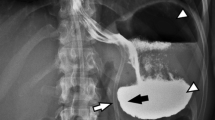Abstract
Background
Laparoscopic adjustable gastric banding (LAGB) slippage with pouch dilation is one the most serious long-term complications and requires reoperation in most cases. It is still controversial whether banding should be offered again or a different procedure should be chosen. We report the results of synchronous de-rebanding on a prospective series of patients treated at our institution for slippage with pouch dilation.
Methods
From January 2000 to May 2007, 29 consecutive patients underwent laparoscopic de-rebanding for slippage with pouch dilation. The mean age at primary operation was 38.9 ± 8.2 years and the mean BMI was 46.4 ± 8 kg/m2. Twenty-eight had previous LAGB, while one had previous open gastric banding, the perigastric technique being used at that time. All the redo procedures were successfully carried out under laparoscopy, via the pars flaccida technique, and all the patients were followed-up according to the usual schedule.
Results
The mean time from the original LAGB was 45.3 ± 30.3 months, and the mean follow-up after rebanding was 26.9 ± 20.6 months. At rebanding, the mean BMI was 34.3 ± 7.6, percent excess weight loss (%EWL) 54.5 ± 31, and percent excess BMI loss (%EBL) 58.3 ± 33, respectively. After 1 year, BMI was 36.3 ± 7.9, %EWL 40.8 ± 30.5, and %EBL 43.9 ± 32.7, respectively. After 2 years, BMI was 37.13 ± 7.4, %EWL 36.9 ± 29.4, and %EBL 39.6 ± 31.6, respectively, and after 3 years, BMI was 33.5 ± 5.6, %EWL 51.9 ± 24.3, and %EBL 55.7 ± 25.7, respectively. One patient had re-rebanding after 6 months for a new slippage, two had band removal with refusal to switch to another procedure, one had biliopancreatic diversion for slippage recurrence, and one underwent sleeve gastrectomy for insufficient weight loss after 6 months.
Conclusions
Although this is a limited series, our results show that good outcomes can be expected after rebanding in properly assessed patients with slippage and pouch dilation. Larger series and longer follow-up are needed to confirm these findings.


Similar content being viewed by others
References
Favretti F, Segato G, Ashton D, et al. Laparoscopic adjustable gastric banding in 1,791 consecutive obese patients: 12-year results. Obes Surg. 2007;17:168–75.
O’Brien PE, McPhail T, Chaston TB, et al. Systematic review of medium-term weight loss after bariatric operations. Obes Surg. 2006;16:1032–40.
Buchwald H. Bariatric surgery for morbid obesity: health implications for patients, health professionals and third-party payers. J Am Coll Surg. 2005;200:593–604.
Korenkov M, Shah S, Sauerland S, et al. Impact of laparoscopic adjustable gastric banding on obesity comorbidities in the medium- and long-term. Obes Surg. 2007;17(5):679–83.
Busetto L, Sergi G, Enzi G, et al. Short-term effects of weight loss on the cardiovascular risk factors in morbidly obese patients. Obes Res. 2004;12(8):1256–63.
Chapman AE, Kiroff G, Game P, et al. Laparoscopic adjustable gastric banding in the treatment of obesity: a systematic literature review. Surgery. 2004;135:326–51.
Dargeant J. Pouch dilatation and slippage after adjustable gastric banding: is it still an issue? Obes Surg. 2003;13:111–5.
O’Brien PE, Dixon JB, Laurie C, Anderson M. A prospective randomized trial of placement of the laparoscopic adjustable gastric band: comparison of the perigastric and pars flaccida technique. Obes Surg. 2005;15:820–6.
Suter M. Laparoscopic bend repositioning for pouch dialatation/slippage after gastric banding: disappointing results. Obes Surg. 2001;11:507–12.
Muller MK, Attigah N, Wildi S, et al. High secondary failure rate of rebanding after failed gastric banding. Surg Endosc. 2008;22:448–53.
Lanthaler M, Mittermair MD, Erne B, et al. Laparoscopic gastric re-banding versus laparoscopic gastric bypass as a rescue operation for patients with pouch dilatation. Obes Surg. 2006;16:484–7.
Spivak H, Rubin M. Laparoscopic management of lap-band slippage. Obes Surg. 2003;13:116–20.
Biertho L, Steffen R, Branson R, et al. Management of failed adjustable gastric banding. Surgery. 2005;137(1):33–41.
Schouten R, Van Dielen FMH, Greve JWM. Re-operation after laparoscopic adjustable gastric banding leads to a further decrease in BMI and obesity related co-morbididties: results in 33 patients. Obes Surg. 2006;16:821–8.
Ponce J, Fromm R, Paynter S. Outcomes after laparoscopic adjustable gastric band repositioning for slippage or pouch dilation. Surg Obes Relat Dis. 2006;2:627–31.
Deitel M, Gawdat K, Melissas J. Reporting weight loss 2007. Obes Surg. 2007;17:565–8.
Author information
Authors and Affiliations
Corresponding author
Rights and permissions
About this article
Cite this article
Foletto, M., Bernante, P., Busetto, L. et al. Laparoscopic Gastric Rebanding for Slippage with Pouch Dilation: Results on 29 Consecutive Patients. OBES SURG 18, 1099–1103 (2008). https://doi.org/10.1007/s11695-008-9458-2
Received:
Accepted:
Published:
Issue Date:
DOI: https://doi.org/10.1007/s11695-008-9458-2



